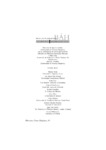Luis de Góngora en la trayectoria aureosecular del epigrama

View/
Use this link to cite
http://hdl.handle.net/2183/12169
Except where otherwise noted, this item's license is described as Reconocimiento-NoComercial-SinObraDerivada 4.0 Internacional
Collections
- Investigación (FFIL) [877]
Metadata
Show full item recordTitle
Luis de Góngora en la trayectoria aureosecular del epigramaAuthor(s)
Date
2013Citation
López Poza, Sagrario, “Luis de Góngora en la trayectoria aureosecular del epigrama”. En Góngora y el epigrama: estudios sobre las décimas, Juan Matas Catallero, José María Micó y Jesús Ponce Cárdenas (eds.), Madrid, Universidad de Navarra, Iberoamericana, Vervuert, 2013, pp. 9-42.
Abstract
Se inicia el trabajo con una introducción al género del epigrama y su preceptiva en el Siglo de Oro. Se expone la metodología empleada para obtener los rasgos definitorios del epigrama a partir del análisis de 350 poemas de autores españoles. Se contrasta lo expuesto en los tratados de Retórica y Poética con la praxis de los autores españoles de los siglos XVI-XVII que son conscientes de practicar el género y se presenta una serie de constantes que le son propias al epigrama de los siglos XVI-XVII en general y al español en particular. Se examinan los rasgos generales, modalidades epigramáticas según los asuntos, aspectos estructurales, elocutivos y estilísticos. Una atención especial se dedica a las estrofas preferidas por nuestros poetas. Tras este panorama, se acomete un estudio de Góngora epigramático. Un 36% de su obra poética encaja en los parámetros del género. Se analizan con detenimiento 154 poemas y se extraen conclusiones sobre la materia o asuntos tratados, modalidades epigramáticas preferidas, producción del género por años, estrofas empleadas y rasgos de estilo. This study begins with an introduction to the gender of the epigram and its peculiarities described in 16th-17th centuries treaties of Rhetoric and Poetics. We expose the methodology employed to obtain the defining features of epigram from the analysis of 350 poems of Spanish authors. We contrast the characteristics called for in the theoretical treatises with the actual practice of Spanish poets who were conscious to be practising this gender. We examine general features, epigrammatic modalities according to the subjects, structural appearances, and stylistic peculiarities. A particular attention is devoted to the metric (type of stanzas) preferred by our poets. Following this overview, a study is undertaken on the practice of epigram by Góngora. 36% of his poetry fits the parameters of the genre. We analyse attentively 154 poems and extract conclusions on the matter or subjects treated, epigrammatic modalities preferred, production of the gender by years, stanzas employed and features of style.
Keywords
Góngora y Argote, Luis de-Crítica e interpretación
Epigramas
Literatura española 1500-1700-Historia y crítica
Epigramas
Literatura española 1500-1700-Historia y crítica
Editor version
Rights
Reconocimiento-NoComercial-SinObraDerivada 4.0 Internacional
ISSN
978-84-8489-721-7






